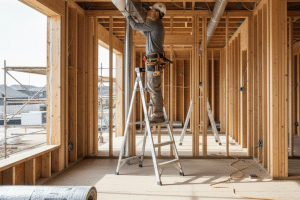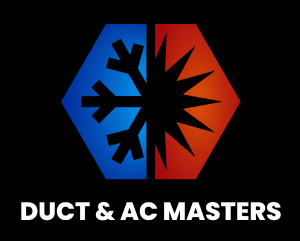
Understanding Ductwork and Its Importance
Ductwork serves as the circulatory system of your home, transporting heated or cooled air from your HVAC unit to various rooms. Properly designed and installed duct systems ensure that air flows efficiently, maintaining consistent temperatures and improving indoor air quality. In a humid climate like South Florida, the significance of effective ductwork installation cannot be overstated.
The Role of Ductwork in HVAC Systems
Ducts are responsible for delivering conditioned air to every corner of your home. They consist of a network of pathways that connect your HVAC equipment to different rooms. When installed correctly, ductwork helps maintain a comfortable indoor environment by:
-
- Ensuring Consistent Airflow: Properly sized and sealed ducts allow for even distribution of air, preventing hot or cold spots in your home.
- Improving Energy Efficiency: Well-installed ductwork minimizes air leaks, which can lead to increased energy consumption and higher utility bills.
- Enhancing Indoor Air Quality: Ducts can filter out dust, allergens, and other pollutants, contributing to a healthier living environment.
Common Ductwork Materials
The materials used for ductwork can vary, each offering distinct advantages and disadvantages. Common materials include:
-
- Sheet Metal: Durable and resistant to corrosion, sheet metal ducts are often the preferred choice for their longevity and efficiency.
- Fiberglass Duct Board: This material combines insulation and ductwork, providing excellent thermal performance but may require more maintenance to prevent dust accumulation.
- Flexible Ducts: Ideal for tight spaces, flexible ducts are easy to install but can reduce efficiency if not properly supported.
The Impact of Humidity on Ductwork Performance
South Florida’s humid climate poses unique challenges for ductwork systems. High humidity levels can lead to various issues, including mold growth, reduced efficiency, and increased energy costs.
Humidity and HVAC Efficiency
When outdoor humidity levels rise, your HVAC system must work harder to remove moisture from the air. This increased workload can strain your system, leading to higher energy consumption and potential breakdowns. Proper ductwork installation can help mitigate these issues by:
-
- Preventing Moisture Infiltration: Well-sealed ducts prevent warm, humid air from entering the system, reducing the burden on your HVAC unit.
- Enhancing Airflow: Properly sized ducts ensure that air moves efficiently, helping to maintain comfortable humidity levels indoors.
Mold and Mildew Concerns
In humid environments, mold and mildew can thrive in damp areas, including ductwork. This not only affects indoor air quality but can also lead to health issues for occupants. To combat this, consider the following:
-
- Regular Inspections: Schedule routine inspections to identify and address any moisture issues in your duct system.
- Use of Antimicrobial Coatings: Applying antimicrobial coatings to duct surfaces can help inhibit mold growth.
Benefits of Professional Ductwork Installation
While DIY projects can be tempting, ductwork installation is best left to professionals. Here are some key benefits of hiring experienced technicians:
Expertise and Knowledge
Professional installers have the training and experience necessary to assess your home’s specific needs. They can determine the appropriate duct sizes, materials, and configurations to optimize airflow and efficiency.
Quality Assurance
When you hire professionals, you can expect a higher level of workmanship. This includes proper sealing, insulation, and testing of the duct system to ensure it operates efficiently.
Long-Term Savings
Investing in professional installation can save you money in the long run. Properly installed ductwork reduces energy consumption, minimizes the risk of costly repairs, and extends the lifespan of your HVAC system.
Planning for Ductwork Installation
Before installation begins, careful planning is essential. This phase involves assessing your home’s layout, HVAC requirements, and potential obstacles.
Assessing Your Home’s Needs
A thorough evaluation of your home will help determine the best ductwork design. Factors to consider include:
-
- Square Footage: Larger homes may require more extensive duct systems to ensure adequate airflow.
- Ceiling Height: Higher ceilings may necessitate larger ducts to maintain proper air distribution.
- Insulation Quality: Well-insulated homes may require smaller ducts, while poorly insulated homes may need larger systems to compensate for heat loss.
Identifying Obstacles
During the planning phase, it’s crucial to identify any potential obstacles that could impact duct placement. Common challenges include:
-
- Load-Bearing Walls: These structures may restrict duct placement and require creative routing solutions.
- Existing Utilities: Electrical wiring, plumbing, and other systems can complicate duct installation, necessitating careful planning.
The Duct Installation Process
The actual installation of ductwork involves several key steps, each requiring precision and expertise.
Step 1: Placing the Plenum
The plenum is the central distribution point for your duct system, connecting directly to your HVAC unit. Proper placement and sizing of the plenum are critical for efficient airflow.
Step 2: Installing Main Trunk Lines
Main trunk lines serve as the primary distribution channels for conditioned air. These ducts should be installed with care to ensure they are properly supported and sealed to prevent air leaks.
Step 3: Connecting Branch Lines
Branch lines connect the main trunk to individual rooms, delivering conditioned air where it’s needed most. Proper routing and sealing of these lines are essential for maintaining airflow efficiency.
Step 4: Sealing and Insulating Ducts
Sealing and insulating ducts is crucial for preventing energy loss. Use high-quality sealants and insulation materials to ensure that your duct system operates at peak efficiency.
Testing and Balancing the Duct System
Once installation is complete, it’s essential to test and balance the duct system to ensure optimal performance.
Airflow Testing
Airflow testing involves measuring the volume of air delivered to each room. This process helps identify any restrictions or imbalances that could affect comfort and efficiency.
Pressure Testing
Pressure testing helps locate any leaks that may have been missed during installation. By pressurizing the duct system, technicians can identify and address even small leaks that could compromise efficiency.
System Balancing
Balancing the system involves adjusting dampers and controls to ensure proper air distribution throughout your home. This step is crucial for achieving consistent comfort in every living space.
Common Ductwork Issues and Solutions
Even with proper installation and maintenance, ductwork systems can develop issues over time. Recognizing common problems and their solutions can help maintain system performance.
Uneven Temperature Distribution
If certain rooms are consistently warmer or cooler than others, it may indicate airflow imbalances. Check dampers and ensure that furniture or other obstructions are not blocking supply or return registers.
Excessive Dust Accumulation
If you notice excessive dust around supply registers, it may indicate duct contamination or filter bypass issues. Regularly check and replace filters to maintain proper airflow and indoor air quality.
Increased Energy Consumption
If your energy bills are rising without a corresponding change in usage, it may be time to evaluate your duct system. Leaky connections or deteriorating insulation can force your HVAC system to work harder, leading to increased costs.
Maintenance Tips for Ductwork
Proper maintenance is essential for ensuring the longevity and efficiency of your ductwork. Here are some tips to keep your system in top shape:
Regular Inspections
Schedule routine inspections to identify any potential issues before they escalate. Technicians can assess the condition of your ductwork and recommend necessary repairs or maintenance.
Filter Maintenance
Dirty or clogged filters can restrict airflow and reduce system efficiency. Establish a regular schedule for checking and replacing filters based on manufacturer recommendations.
Professional Duct Cleaning
Consider professional duct cleaning every few years to remove accumulated dust, allergens, and other contaminants. This service can help maintain healthy indoor air quality and improve system efficiency.
Ductwork installation is a critical aspect of maintaining a comfortable and efficient home in South Florida’s humid climate. By understanding the importance of proper ductwork, the impact of humidity, and the benefits of professional installation, homeowners can make informed decisions that enhance their indoor environment. Regular maintenance and timely repairs will ensure that your duct system continues to operate efficiently for years to come, providing you with the comfort and peace of mind you deserve.
We Provide Duct Work Installation, Repair, & Maintenance
Professional duct work installation, repair, and maintenance are crucial services in South Florida’s unique climate, where high humidity and temperature fluctuations place significant demands on HVAC systems. Properly installed ductwork creates an efficient network that distributes conditioned air throughout your home, while strategic placement of supply registers and return air grilles ensures balanced airflow essential for managing Florida’s intense heat.
> Learn More
Contact Us (954-324-1406) for a Free Consultation!
—
 About Duct and AC Masters
About Duct and AC Masters
Duct and AC Masters is South Florida’s premier solution for all your air system needs. Our certified professionals, competitive pricing, and commitment to customer satisfaction ensure that your HVAC system performs at its best.

 About Duct and AC Masters
About Duct and AC Masters